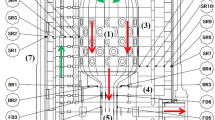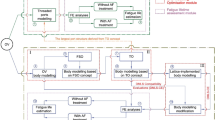Abstract
In this paper, a double-layer half-cycle generator (HCG) has been designed and built. The proposed HCG creates sinusoidal flow with 400 A peak and 5 µs pulse width which feeds RLC load with 100 kHz work frequency, within resonance mode. Previous HCGs have been designed based on saturable reactor (SR). It should be noted that SR is a nonlinear element, and it will be distanced from its desirable performance upon change of temperature and under impact; however, a double-layer HCG has been proposed with no such defects. In proposed HCG, thyristor has been used instead of SR which is controllable, and it has none of aforementioned problems. Also, when SR is eliminated, its reverse retrieval needs no minority carriers. This way, sweep-out circuit may be also eliminated. From among other advantages of proposed HCG, reduction in number of circuit layers may be referred to, comparing to previous HCG. This results in reduction in number of equipment which in turn optimizes proposed HCG, in terms of volume and manufacturing costs. Finally, proposed HCG has been simulated in Matlab, while it has been implemented practically. Comparing simulation results and laboratory sample confirms correctness of relationships, in analytical design of HCG.


























Similar content being viewed by others
References
Lu F, Yan Z, Deng H, Wang Y (2019) Asynchronous discharge of an eight-module superconducting pulsed power supply for driving an electromagnetic railgun. IEEE Trans Appl Supercond 29(2):1–5
McNab IR (2001) Developments in pulsed power technology. IEEE Trans Magn 37(1):375–378
Zhao Q, Li S, Cao R, Wang D, Yuan J (2019) Design of pulse power supply for high-power semiconductor laser diode arrays. IEEE Access 7:92805–92812
Akiyama H, Sakugawa T, Namihira T, Takaki K, Minamitani Y, Shimomura N (2007) Industrial applications of pulsed power technology. IEEE Trans Dielectr Electr Insul 14(5):1051–1063
Zhu Y, Wang Y, Yan Z, Dong L, Xie X, Li H (2010) Multipole field electromagnetic launcher. IEEE Trans Magn 46(7):2622–2627
Li H, Zhang Y, Zhang C, Gao M, An Y, Zhang T (2018) A repetitive inductive pulsed power supply circuit topology based on HTSPPT. IEEE Trans Plasma Sci 46(1):134–139
Strowitzki C, Seckl P, Zacharias P (2011) A novel solid state pulsed power module for excimer laser. IEEE Trans Dielectr Electr Insul 18(4):1236–1241
Wisken HG, Weise THGG (2003) Capacitive pulsed power supply systems for ETC guns. IEEE Trans Magn 39:501–504
Xia S, He J, Chen L, Xiao Z, Wang Z, Dong M (2009) Development of a capacitive pulsed power supply for high-current high-velocity sliding electrical contact studies. IEEE Trans Magn 45(1):555–558
Sitzman A, Surls D, Mallick J (2007) Design, construction, and testing of an inductive pulsed-power supply for a small railgun. IEEE Trans Magn 43(1):270–274
Liu X, Yu X, Ban R, Li Z (2017) Analysis of the capacitor-aided meat grinder circuits for an inductive pulsed power supply. IEEE Trans Plasma Sci 34:45. https://doi.org/10.1109/tps.2017.2705179
Aso Y, Hashimoto T, Abe T, Yamada S (2009) Inductive pulsed-power supply with marx generator methodology. IEEE Trans Magn 45(1):237–240
Chen L, Liu Y, Arsoy AB, Ribeiro PF, Steurer M, Iravani MR (2006) Detailed modeling of superconducting magnetic energy storage (SMES) system. IEEE Trans Power Deliv 21(2):699–710
Wang Y, Liu K, Qiu J, Dong W (2019) A stage–stage paralleled topology of all-solid-state marx generator for high current. IEEE Trans Plasma Sci 47(10):4488–4494
Zhang X, Li Z, Li H, Zhang C, Liu S (2017) A zero-current opening circuit for inductive pulsed-power supply based on high-temperature superconducting pulsed-power transformer. IEEE Trans Plasma Sci 45(9):2536–2540
Liu P, Li J, Gui Y, Li S, Zhang Q, Su N (2011) Analysis of energy conversion efficiency of a capacitor-based pulsed-power system for railgun experiments. IEEE Trans Plasma Sci 39(1):300–303
Lv Q, Lei B, Gao M, Li Z, Chi X, Li H (2009) Magnetic flux compression generator as future military pulsed power supply. IEEE Trans Magn 45:545–549
Veilleux E, Ooi B-T, Lehn PW (2013) Marx dc–dc converter for highpower application. IET Power Electron 6(9):1733–1741
Sitzman A, Surls D, Mallick J (2005) STRETCH meat grinder: a novel circuit topology for reducing opening-switch voltage stress. In: Proceedings of 13th IEEE international pulsed power conference, Monterey, CA, USA, pp 493–496
Liu X, Yu X (2017) The meat grinder with CPFU: a novel circuit for inductive pulsed power supplies. IEEE Trans Plasma Sci 45:2546–2551
Johannssen E, Johannssen PR, Grebnev A (2010) Accufix system enhancements for eLORAN. Megapulse Incorporated
Pinguet S, Dupéroux JP, Delmote P, Bieth F, Bischoff R (2013) Short-pulse Marx generator for high-power microwave applications. IEEE Trans Plasma Sci 41:2754–2757
Scharnholz S, Brommer V, Buderer G, Spahn E (2003) High-power MOSFETs and fast-switching thyristors utilized as opening switches for inductive storage systems. IEEE Trans Magn 39(1):437–441
Wang H, Xie L, Zhang G, He X, Chen Z (2015) A 50 kJ inductive–capacitive storage module with solid-state high-power opening switch based on counter-current thyristor. IEEE Trans Plasma Sci 43(8):2658–2662
Dishal M (1973) LORAN transmitters using high power half cycle generators. In: Second annual symposium, Washington DC
Fox JE (2006) Performance study of the loran-C system in the presence of wideband interference. Thesis, University of Tennessee, Knoxville
Williams P, Last D (2006) Modelling LORAN-C envelope-to-cycle differences in mountains terrains. Technical Report, University of Wales, Bangor, UK
Johannessen P (2006) Method of and apparatus for increasing the peak output pulse power delivered by capacitor-driven high-power diode and square-loop saturable reactor pulse compression generators with the aid of minority carrier sweep-out circuits within the pulse compression circuit. US. Patent No. US7064705 B2, 20
Author information
Authors and Affiliations
Corresponding author
Additional information
Publisher's Note
Springer Nature remains neutral with regard to jurisdictional claims in published maps and institutional affiliations.
Rights and permissions
About this article
Cite this article
Alizadeh Pahlavani, M.R., Shahraeini, M., Dehestani Kolagar, A. et al. Optimal design and implementation of a half-cycle generator with the range of 400 A and 100 kHz frequency. Electr Eng 102, 1739–1753 (2020). https://doi.org/10.1007/s00202-020-00981-0
Received:
Accepted:
Published:
Issue Date:
DOI: https://doi.org/10.1007/s00202-020-00981-0




